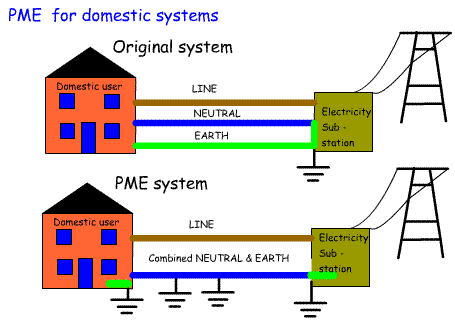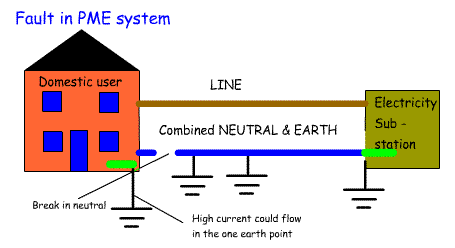
| ADVANCED LESSON 70 |  |
| LEARNING OBJECTIVES and NOTES | |
| Safety - Protective multiple earthing | |
|
9f.1 Recall that in PME systems the main earth terminal is connected to
the neutral of the electricity service at the consumers' premises and
that all metal pipes and fittings within the premises are also
connected to the PME bonding point. Recall that under severe fault conditions PME systems have the potential to cause fatal electric shocks and/or fires in amateur radio stations. Recall that the RF earth in an amateur station should be connected to the PME bonding point in accordance with IEE Wiring Regulations to maintain safety under fault conditions. The traditional method of connecting up a mains electricity supply to property has been to have have a LIVE, NEUTRAL and EARTH wire to all sockets. These then run back to the sub-station where the earth and neutral are joined together. An alternative system used in many installations since the 70's is to use a protective Multiple Earthing system (PME). In this system the mains earth terminal is connected to the neutral and all metalwork in the house is connected to the same point. The feed from the sub station is a combined neutral and earth. The advantage of this is that it provides the domestic consumer with a very reliable earthing system. The purpose of the earth is to provide a low impedance to ground. If the 230V live touches the chassis a high current flows through to the earth and the fuse blows. In the original system the sheath of the cable back to the sub station provided a low impedance earth. In the PME system the well earthed combined earth and neutral also provided a low impedance PME only requires two wires and is easier to tap into for new connections to the mains. So, what is the problem with PME? There is normally a small difference in voltage between the combined Neutral and earth and earth itself. However if there is a break in the combined neutral and earth this could leave the appliance with a less effective earth For example if there was a break between the appliance and the first external earthing point any current from an appliance where the live was touching the chassis would only have the house earth to depend on. If this was a high impedance, a high current would flow which may not blow the fuse, but could cause a fire or electrocute someone touching any metalwork in the house which has been bonded to the PME system. What about RF earths? The advice if you have a PME system is to bond the RF earth to the PME earth/neutral wire. This will ensure that there is no voltage difference between RF earth and the PME earth. There are clear IEE guidelines about the bonding method to be used. Where the neutral cable is less than 35 sq mm then the bonding conductor should be at lease 10 sq mm |
  |